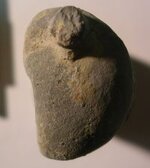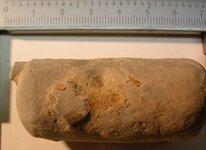This is the best I could do last weekend. Just the mud infill of the body chamber of a large endocerid, would have been about 4 to 5 feet long I guesstimate. A small peice of the endocones is visible in the first photo (upper right corner), with some mud filling the siphuncle at the end of the body chamber producing the nob. And an end view showing the shape of the shell and location of the siphuncle.
You are using an out of date browser. It may not display this or other websites correctly.
You should upgrade or use an alternative browser.
You should upgrade or use an alternative browser.
Fossil Living Chamber
- Thread starter Architeuthoceras
- Start date
- Joined
- Apr 8, 2004
- Messages
- 601
Big Kev, never realised endocerids had knobs ! 
though it looks more like a rather attractive hammer to me !
sorry
Keef
though it looks more like a rather attractive hammer to me !
sorry
Keef
spartacus said:Big Kev, never realised endocerids had knobs
It's the thing next too the head
- Joined
- Apr 8, 2004
- Messages
- 601
methinks Big Kev has got "eagle eyes" !
Keef
Keef
Here are two casts of body chamber and siphuncle found in shale over the weekend. They are both showing the bottom side, hence the small trilobite mold in the upper pic is a mold of the top of the trilobites shell. There is also a graptolite laying along side the siphuncle in the top pic. Also in the top pic you can see a ghost of the phragmocone and chambers that dissolved probably before the surrounding shale turned to stone.
Attachments
Here is an internal mold of the body chamber and siphuncle inside an external mold of the shell. All trace of the shell material has dissolved leaving the internal mold and a hollow where the gas filled chambers and the shell material used to be. The shell in this example probably dissolved after the surrounding mud had turned to stone, so the hollow was preserved.
Attachments
- Joined
- Mar 23, 2005
- Messages
- 3,026
You had a productive weekend. Good finds.
- Joined
- Oct 19, 2006
- Messages
- 72
Wow, these are amazing! Where did you collect them?
They all were found in the informal Calathium Calcisiltite Member of the Fillmore Formation, in the Ibex region of western Utah. Of course it is a secret spot and if I told you exactly where it was I would have to make a call and have something done about it 
By the way, they were not collected, just photographed in the field and marked with a GPS.
By the way, they were not collected, just photographed in the field and marked with a GPS.
Similar threads
- Replies
- 0
- Views
- 2K
- Replies
- 0
- Views
- 1K
















